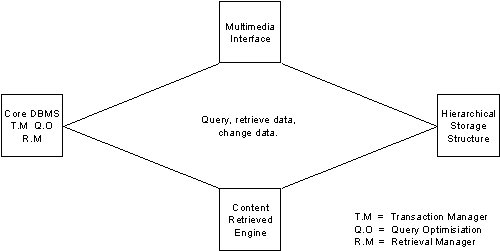multimedia databases
In addition to the standard numeric, date and text data types, there are a number of data types that are regarded as the basic building blocks of MM applications. These data types, which are elements of more complex MM objects, are:
- text – different fonts and to produce special effects such as colour and fill.
- audio – various audio file formats include Microsoft WAV (wave) and MIDI, which is a more compact representation of sound.
- still images – pixels can be 0 or 1 (‘white’ or ‘black’) or hi-res colour images with 8, 16 or 24 bits per pixel.
- digital video – usually stored as a sequence of frames. For realistic playback, the transmission, compression, and decompression of digitized continuous frames requires transfer rates of 30 frames per second. If audio is required as well, the audio and video must be interleaved so that the sequences can be timed properly. Microsoft’s AVI format can synchronize playback of audio and video.
- graphical objects – such as 2- and 3-dimensional images.
Most of these data types require a lot of storage space. An average page of text may require about 2 KB; 75 minutes of high-fidelity music may need 100MB; a full page, still image varies from about 10KB for black-and-white to several megabytes for colour; a video frame may require 1 MB of storage so a video clip lasting a second needs something of the order of 3 0MB. Compression techniques are available to reduce these storage requirements but it will be clear that MM still needs a lot of storage space.
MMDBs require all the basic attributes of a database management system such as a transaction manager, query optimizer, recovery manager etc. as well as special storage structures and specialized search and querying modules.
Typical architecture of a MMDB application
Since existing relational and OO databases comprise the basic requirements of any database, it is natural that many multimedia and imaging DB applications are constructed within such existing systems. In order to support such applications, many DBMS vendors offer facilities suitable for MM. These include:
- long bit and byte strings
- BLOBS
- paths or references of images where the actual image stored elsewhere, such as on an optical storage subsystem. The reasons for this are that document imaging systems need on-line, near-line and off-line storage of images, including archiving. This may be achieved by the use of optical jukeboxes but most commercial DBMSs do not directly support optical storage subsystems (Informix Online/optical is an exception).
- Content retrieval capabilities. In conventional relational and OO DBs querying is based on the attributes of objects. However, information retrieval and document imaging systems require searching the content of documents. This ability can be
generalized to still images, audio and video.
Characteristics of Multimedia and Imaging Databases
1. Support for imaging and multimedia data types plus
2. the capacity to handle many MM objects plus
3. support for suitable storage management plus
4. database capabilities (transaction/concurrency control, integrity, etc) plus
5. information retrieval capabilities (including exact match and probabilistic retrieval)


